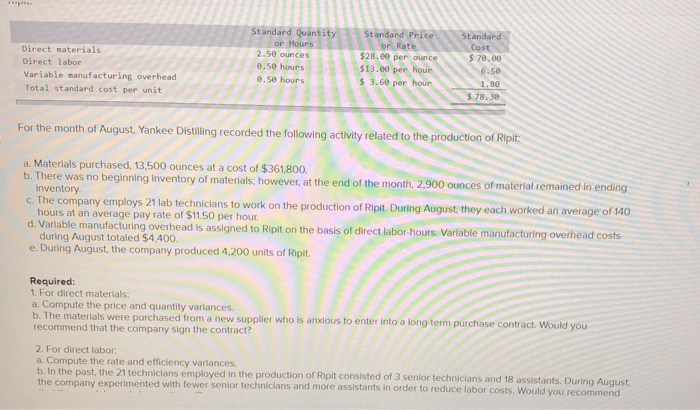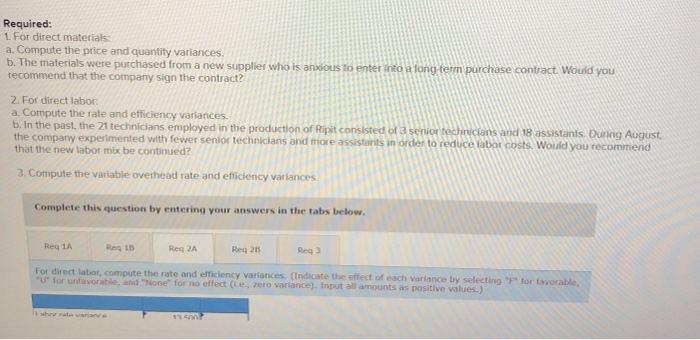Direct materials Direct labor Variable manufacturing overhead Total standard cost per unit Standard Quantity or Hours 2.50 ounces 0.50 hours 0.50 hours Standard Price or Rate $28.00 per ounce $13.00 per hour $ 3.60 per hour Standard Cost $ 70.00 6.50 1.80 $ 78.30 For the month of August, Yankee Distilling recorded the following activity related to the production of Ripit: a. Materials purchased, 13,500 ounces at a cost of $361,800. b. There was no beginning inventory of materials; however, at the end of the month, 2,900 ounces of material remained in ending Inventory c. The company employs 21 lab technicians to work on the production of Ripit. During August, they each worked an average of 140 hours at an average pay rate of $11.50 per hour. d. Variable manufacturing overhead is assigned to Ripit on the basis of direct labor hours. Variable manufacturing overhead costs during August totaled $4,400. e. During August, the company produced 4,200 units of Ripit. Required: 1. For direct materials: a. Compute the price and quantity variances. b. The materials were purchased from a new supplier who is anxious to enter into a long-term purchase contract. Would you recommend that the company sign the contract? 2. For direct labor a. Compute the rate and efficiency variances. b. In the past, the 21 technicians employed in the production of Ripit consisted of 3 senior technicians and 18 assistants. During August, the company experimented with fewer senior technicians and more assistants in order to reduce labor costs. Would you recommend Required: 1. For direct materials: a. Compute the price and quantity variances. b. The materials were purchased from a new supplier who is anxious to enter into a long term purchase contract. Would you recommend that the company sign the contract? 2. For direct labor a. Compute the rate and efficiency variances. b. In the past, the 21 technicians employed in the production of Ripit consisted of a senior technicians and 18 assistants. During August, the company experimented with fewer senior technicians and more assistants in order to reduce labor costs. Would you recommend that the new labor mix be continued? 3. Compute the variable overhead rate and efficiency variances Complete this question by entering your answers in the tabs below. Reg 1A Reg 13 Reg 2 Reg 26 Reg 3 For direct labor, compute the rate and efficiency variances. (Indicate the effect of each variance by selecting "F" for favorable, "U" for unfavorable, and "None" for no effect (1.e., zero variance). Input all amounts as positive values.)








